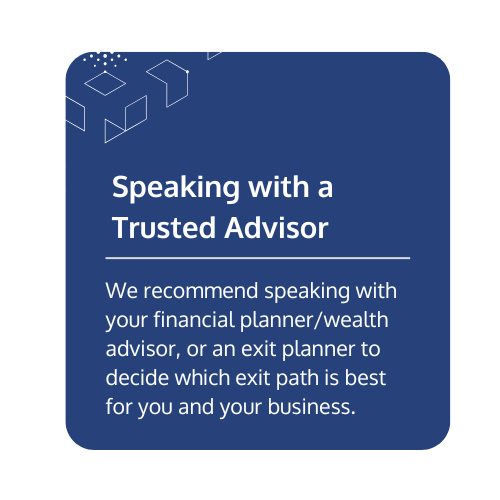Exiting Your Business
Is a Complex Decision
Selling Isn’t Your Only Option
80% of businesses that are listed for sale never sell,
but a sale is not your only option
You need to be sure you are choosing the right exit path.
Taking the time to review your options to ensure you are making the right decision for yourself and your business while also maximizing the value you receive when stepping down is the best way to successfully make your exit.
1. Initial Public Offering (IPO)
An Initial Public Offering (IPO) is the most complex way you can choose to exit your business.
There are many obstacles that come with an IPO, including regulatory oversight and disclosure requirements. By offering up shares of the company to the public for the first time, you are also opening up your company to increased scrutiny.
This is also a costly exit path, with fees costing upwards of several million dollars to fund the exchanges, the brokers, the marketing, etc.
When choosing this exit path, we recommend that you plan meticulously and comply with all regulatory requirements.
Capital Concepts Recommendation:
This is not often a path we recommend due to its high complexity level, regulatory oversight and disclosure requirements, and cost.
2. Sales to Employees (ESOP)
Sale to Employees or ESOP is a preferred option for business owners who are invested in preserving the company’s legacy and empowering its current employees. This exit path is becoming an increasingly popular way of selling a company; major recognizable corporations across the country are now employee-owned companies.
This does not mean it does not have complexities; an ESOP is guided by ERISA rules since it is considered a form of a retirement plan for employees. Every employee would become an owner over time.
A trustee will need to be involved with this type of sale. Annual valuations will also need to be performed due to the options and shares needing to be valued each year.
Because of the fees required, an ESOP is not recommended for smaller companies. A large number of employees is needed to make the fees required justifiable.
Capital Concepts Recommendation:
While the complexity level of an ESOP is on the higher end, this is one of our preferred options for a business exit if your company fits the criteria.
3. Recapitalization (Recap)
Complexity Level: 3 ![]()
Recapitalization (Recap) is typically an option chosen by business owners who have goals for their company that they have not been able to achieve on their own.
A Recap occurs when an outside strategic partner invests in the business to help take it to the next level. A business owner might choose this exit path when they have taken their business to a certain financial level; with a private equity group backing the business, it could grow exponentially in a set period of time which can provide a large difference in valuation.
You will often see a Recap include provisions for the business owner to stay on board for a set period of time and there may also be incentives included for the owner who stays on.
By providing a path for business growth through an influx of funds, the business owner can see a higher valuation of their company from a Recap than another exit option like a sale.
Capital Concepts Recommendation:
A Recap is optimal for owners who want to participate in the potential growth of their business and increase the company’s value before exiting.
4. Management Buyout (MBO)
Management Buyouts occur when an existing manager or management team purchases the business from the current owner or owners.
As always, this will vary by business, but ideally this is an amicable exchange – who better to run a company than the experienced manager or management team when an owner is ready to exit? A MBO can also provide the company and employees with a sense of stability through the transition to new ownership as it is already familiar with the management team.
To successfully exit a business through a MBO, we recommend attentive planning. Each side would need to perform financial diligence and bring in their own valuation experts, with the goal of a fair deal for all parties.
Capital Concepts Recommendation:
A MBO can be an ideal option for a company with a strong leadership team to ensure a smooth transition as long as there is careful planning to secure a fair deal for all parties involved.
5. Sale to Third-party
Complexity Level: 3 ![]()
The most common way we see people choose to exit their business is via a sale to a third party. However, 80% of businesses that are listed for sale never sell, usually due to lack of planning and no dedicated exit path.
One of the main pitfalls we see owners fall into when selling to a third party is not entering the sale conversation with a strategy; this leads to them falling prey to a quick and convenient transaction without gaining the full potential value of the business.
To ensure success when listing your business for sale, we recommend proper planning. This will allow you to perform research and have a solid exit strategy to ensure you are receiving the best value for your company.
Capital Concepts Recommendation:
While this is the most common way to exit a business, it is not always the best option for receiving the highest value or for legacy preservation.
6. Sale to Existing Partners
If you are in a company where you are one of multiple partners with an ownership stake in the business, a Sale to Existing Partners is a viable exit path for you.
We always recommend planning for your business exit in advance and if you planned far enough ahead, there would be a calculation agreement inserted into your business partnership agreement. However, we recognize a few things – first, that is not common and second, an agreement created in advance might not be fair in the current market conditions you are experiencing when you’re ready to exit.
With this exit path, each side may perform a valuation of the business or they may agree on a mutual valuation. Complexities can occur if the two or more parties place a different value on the company or parts of the company.
This option also provides a way for the company to see a smooth transition as the owner exits due to the familiarity and trust that the company and employees hopefully have with the existing partners.
Capital Concepts Recommendation:
Similarly to a MBO, a Sale to Existing Partners can be a preferred option for a business owner who is looking for a smooth transition in ownership, provided there is careful planning and a fair deal on both sides of the transaction.
7. Intergenerational Transfer
Complexity Level: 2 ![]()
You have worked hard to build a business and a legacy you are proud of and what better way to continue than to exit and leave your company to your children?
While an Intergenerational Transfer may be a decision led by emotion, it does not make it any less of a viable exit path.
Intergenerational Transfers are not the most common exit path; in fact, only about 30% of business transfers that actually go through are intergenerational transfers. As seen with selling to a third party, this is often due to a lack of planning and no dedicated exit path, even if an owner wants to leave the company to their children or family.
However, this strategy is preferred for business owners who have children who have worked in the business prior to the transfer and will continue as the owner when the intergenerational transfer occurs.
Capital Concepts Recommendation:
An Intergenerational Transfer is an ideal option for business owners who are looking to preserve a legacy by continuing the company under a relative, typically a child or children; it works best when the child or children are already a part of the company upon the owner’s exit.
8. Orderly Liquidation
The business world can be tough and with fluctuating economic conditions, there may come a time when it is simply not feasible to move forward with your business.
If all other options are exhausted, an Orderly Liquidation is a solid exit strategy that will still allow you to receive funds from the sum of the assets of your business after any debts and payouts.
This path is typically chosen either when internally there is no other option to continue the business or a court order is placed to repay debts.
With this exit strategy, the company ends, all payouts are negotiated, and all business assets and inventory are sold.
Capital Concepts Recommendation:
If there is no other option for the business to go on, an Orderly Liquidation is a viable exit path to wind down operations and close out any remaining inventory and assets.
How Do I Choose My Exit Path
Exiting your business can be an emotional decision and hard choices may need to be made in the process.
You may not only be concerned with maximizing your return from your company, but also with preserving your legacy or ensuring your employees are cared for after the business has transferred to new ownership.










